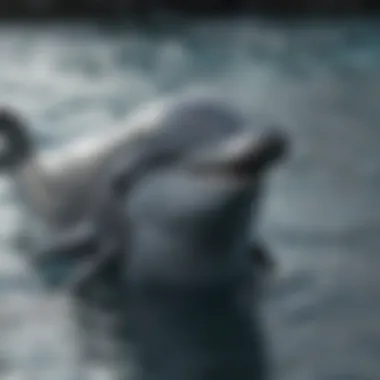Understanding Dolphin Morphology: An In-Depth Analysis


Intro
Dolphins are captivating creatures that inhabit our oceans. Their unique physical traits and social structures have drawn the interest of researchers and wildlife enthusiasts. Understanding dolphin morphology helps us appreciate their adaptations to marine life and the ecological roles they fulfill.
Fascinating Facts About the Animal
Unique Characteristics
Dolphins exhibit a wide range of physical features that make them stand out in the animal kingdom. They possess streamlined bodies, which aid in efficient swimming. Most dolphins have a pronounced beak, referred to as a rostrum. This feature aids in capturing prey. The dorsal fin, located on their backs, plays a role in stability and helping them maneuver through water.
Furthermore, dolphins have a thick layer of blubber that provides insulation in cold waters. Skin coloration varies among species, with many dolphins displaying a mix of grays and blues, often with lighter undersides. This coloration provides camouflage when viewed from above or below, an important trait in avoiding predators and stalking prey.
Extraordinary Abilities
Dolphins are known for their remarkable cognitive skills and social behaviors. They have complex communication systems, utilizing a variety of sounds and body language. Research shows that dolphins can recognize themselves in mirrors, indicating a level of self-awareness not present in many other species.
In addition to their intelligence, dolphins are capable of incredible physical feats. They can swim at speeds up to 37 km/h (23 mph) and can perform acrobatic jumps out of the water. Their echolocation ability allows them to navigate and hunt in dark or murky waters, further showcasing their unique adaptations.
Prolusion to Dolphin Morphology
Dolphin morphology is a significant subject in marine biology. It encompasses more than just the physical attributes of dolphins. Understanding their shape, size, and anatomical features provides insights into their behaviors, habitats, and evolutionary history. The morphological study aids in various fields, from conservation efforts to wildlife management. By comprehending how dolphins have adapted to their environment, researchers can make informed decisions regarding their protection and study. The appeal of this topic extends beyond academia, reaching families and wildlife enthusiasts who are keen to learn more about these fascinating marine mammals.
Significance of Studying Dolphin Appearance
Studying dolphin appearance is essential for several reasons. Firstly, their morphology can indicate their health and fitness. Variations in size, shape, or skin can be signs of environmental stress or disease. Secondly, dolphins serve as crucial bioindicators in marine ecosystems. Changes in their appearance can reflect broader ecological conditions. Additionally, understanding their external features helps researchers understand their social structure. Differences in coloration and markings can play a role in communication and identification among individuals. Overall, dolphin morphology presents a multifaceted picture that aids in species understanding and conservation strategies.
Overview of Dolphin Species
Dolphins are a diverse group of marine mammals, belonging to the family Delphinidae. This family includes species such as the Common Bottlenose Dolphin, Orca, and Spinner Dolphin. Each species showcases unique physical and behavioral characteristics. The Bottlenose Dolphin is well-known for its intelligence and adaptability. In contrast, the Orca, or killer whale, is recognized for its striking black and white coloration and complex social structures. The Spinner Dolphin, famous for its acrobatic spins, provides insight into the adaptations for speed and agility in water. Recognizing the diversity among dolphin species is key to understanding their ecological roles and contributions to marine environments.
General Physical Characteristics
Understanding the general physical characteristics of dolphins is essential for grasping the broader context of dolphin morphology. These traits form the basis of how dolphins interact with their environment, hunt for prey, and communicate with each other. The significance lies not only in biological terms but also in ecological implications, as these physical attributes can indicate overall health and adaptation to changing marine conditions.
Analyzing body size, shape, skin texture, and color patterns allows researchers to draw connections between physical adaptations and survival strategies in diverse habitats. Furthermore, this understanding is valuable for conservation efforts and wildlife management practices.
Body Size and Shape
The body size and shape of dolphins vary among species, reflecting their adaptations to different ecological niches. Generally, dolphins exhibit streamlined bodies that facilitate efficient movement through water. This design minimizes drag and allows for agile swimming, which is crucial when pursuing prey or escaping predators.
Key Aspects of Dolphin Body Size and Shape:
- Size Range: Dolphins can range significantly in size. The common bottlenose dolphin typically measures between 2 to 4 meters in length, while the orca can exceed 8 meters.
- Body Shape: Most dolphins have a torpedo-like shape, which is optimal for swimming. Their body contours often include a rounded snout, a robust midsection, and a tapering tail.
- Sexual Dimorphism: In some species, such as orcas, males tend to be larger than females. The difference can be observed in both length and dorsal fin size.


Overall, body size and shape are influenced by evolutionary pressures and habitat requirements. Knowledge of these physical traits is essential for understanding dolphin behavior and their role within marine ecosystems.
Skin Texture and Color Patterns
The skin texture and color patterns of dolphins are not just aesthetic features; they serve crucial functional purposes as well. The smooth, rubbery outer layer reduces drag while swimming, allowing for efficient movement. Moreover, color patterns vary significantly among dolphin species, often providing camouflage against ocean predators and prey.
Important Factors in Dolphin Skin Texture and Color Patterns:
- Texture: Dolphin skin is generally very smooth, which aids in hydrodynamics. The skin has layers of specialized cells that create a slimy coating, reducing friction with water.
- Coloration: Colors range from shades of gray to blue, often with lighter bellies for counter-shading. This trait helps dolphins blend into the surrounding water environment, offering protection against predators.
- Markings: Specific species, like the spinner dolphin, may exhibit distinctive markings or patterns that can differentiate individuals or even indicate health status.
Anatomical Features
Anatomical features of dolphins play a crucial role in understanding their morphology. Not only do these structures enable dolphins to thrive in their aquatic environments, they also provide insights into their behavior and adaptation strategies. Studying these features can aid in conservation efforts and enhance our knowledge about their ecological roles.
Dorsal Fin: Function and Variations
The dorsal fin in dolphins is more than just a signature characteristic. It serves multiple functions. Primarily, it helps maintain balance while swimming, reducing the risk of rolling over in the water. The shape and size of the dorsal fin can vary significantly among species. For instance, the bottlenose dolphin typically has a curved fin, while the orca demonstrates a taller and straighter dorsal fin. This variance can be attributed to different swimming patterns and habitat preferences. Some scientists argue that these differences may also play a role in thermoregulation, as a larger fin might dissipate heat more efficiently in warmer waters. Furthermore, the dorsal fin can act as a communication tool. Dolphins often use their fins during social behaviors, displaying them to others in their pod. Overall, understanding the dorsal fin's role enhances our comprehension of dolphin adaptation and behavior in marine ecosystems.
Pectoral Flippers: Structure and Purpose
Pectoral flippers in dolphins are instrumental for maneuverability and steering. These flippers are structured differently compared to fish fins; they have a more muscular build and are shorter in proportion to the body. This design provides agility, enabling dolphins to perform intricate movements, dive, and turn swiftly. The bones of the pectoral flippers resemble those of a human arm, which suggests a unique evolutionary path. Also, the skin covering the flippers has a specialized texture that may aid in creating lift during movement. It's worth noting that pectoral flippers can vary in size and shape between dolphin species as well. For example, the spinner dolphin has elongated flippers that contribute to its remarkable swimming speed. By examining the structure and purpose of these flippers, we gain insights into each species’ way of life and ecological interactions.
Tail Flukes: Propulsion Mechanics
Tail flukes, or the caudal fins, are pivotal in providing propulsion for dolphins. They work in a unique up-and-down motion, unlike a fish's side-to-side propulsion. This vertical movement allows for a more efficient swim, particularly for longer distances. The flukes are large and broad, which helps generate the necessary force to propel the dolphin forward. The muscles that control this movement are powerful and adapted for rapid contractions, which are essential during pursuits or escapes from predators. Additionally, the shape of the tail flukes can differ based on species. For example, the orca has a prominent, triangular fluke, facilitating its powerful swimming ability. Interestingly, research suggests that the fluke's surface area can impact the dolphin’s speed and agility, making this anatomical feature vital for understanding their swimming adaptations.
Understanding the mechanics of dolphin propulsion can provide insights into their hunting strategies and energy conservation in various marine environments.
Diversity in Dolphin Species
Diversity among dolphin species plays a crucial role in understanding their overall morphology. Each species possesses unique characteristics shaped by their specific environmental needs and evolutionary history. This diversity not only enriches our knowledge of marine biology but also aids in conservation efforts. By studying various species, we can unveil how different adaptations allow dolphins to thrive in their habitats. Furthermore, this examination can inform how changes in the marine environment impact these species differently.
Common Bottlenose Dolphin: A Closer Look
The Common Bottlenose Dolphin, scientifically known as Tursiops truncatus, is perhaps the most recognized dolphin species. It exhibits a robust body with a pronounced beak and a dorsal fin that can vary in size and shape depending on the region it inhabits. They can grow up to 4 meters in length. Their skin is typically a gray color, often with lighter underbellies.
In terms of behavior, Common Bottlenose Dolphins are known for their high intelligence and social nature. They often form complex social groups known as pods. This species is also well noted for its strong capability for vocal communication and echolocation, which it uses to navigate and hunt in deeper waters.
Orca: Unique Physical Traits
Orcas, or Orcinus orca, stand out with their distinctive black-and-white coloration. Males tend to be larger than females, reaching lengths of up to 9 meters, while females typically measure around 7 meters. The dorsal fin of the male is notably tall, rising up to 2 meters, which is a key physical trait used for identification.
Orcas possess complex social structures, called matrilines, where pods are often formed around a maternal figure. Additionally, they are skilled hunters, employing sophisticated cooperative techniques to catch prey. Their diverse diet includes fish, seals, and even whales. This adaptability in feeding habits is a significant evolutionary trait that supports their survival in varying marine ecosystems.
Spinner Dolphin: Adaptations for Speed


The Spinner Dolphin, or Stenella longirostris, is named for its unique behavior of spinning in the air. This species is smaller than the Bottlenose Dolphin, typically ranging from 1.5 to 2.5 meters. Its streamlined body is built for agility and speed, making it one of the fastest dolphin species.
Spinner Dolphins are also known for their remarkable social structures and behaviors. They often engage in acrobatics, which may serve as a means of social interaction and play. Also, they tend to inhabit tropical and subtropical waters, often seen in large groups which can enhance their protection from predators. Their adaptations for speed and maneuverability provide not only a means to escape threats but also an advantage in hunting agile fish.
The diversity within dolphin species illustrates the complex interplay between morphology and environment, highlighting the significance of evolutionary adaptations in marine ecosystems.
Evolutionary Adaptations
Evolutionary adaptations are crucial in understanding dolphin morphology. These adaptations highlight how dolphins have evolved over time to survive and thrive in diverse marine environments. Each morphological feature plays a significant role in their overall functionality and ecological success.
Evolution of Dolphin Morphology
The evolution of dolphin morphology is a fascinating journey that begins with their ancestors. Dolphins originally evolved from land-dwelling mammals, adapting to an aquatic life. Over millions of years, they developed streamlined bodies to enhance swimming efficiency. Key adaptations include the reduction of limbs to form flippers and modifications in their body shape to minimize drag in the water.
This process has provided numerous benefits. For instance, the placement of their blowhole on top of the head allows for easier breathing while swimming. Additionally, a layer of fat, called blubber, provides insulation against cold water, contributing to their survival in various climates.
Diversity among species also demonstrates how specific adaptations address unique environmental challenges. For example, the common bottlenose dolphin has a robust, social structure that supports group living, while the orca has adapted to prey on larger animals, showcasing specialized hunting features.
Impact of Habitat on Dolphin Appearance
The habitat of a dolphin significantly influences its morphological traits. Factors such as water temperature, salinity, and prey availability lead to variations in skin texture and coloration. For example, dolphins residing in tropical waters often display lighter, more vibrant colors compared to those in colder regions, where darker shades may provide better camouflage against predators.
Additionally, dolphins that inhabit different ecological niches might exhibit distinct anatomical features. Those living in deeper waters may develop larger flippers for enhanced maneuverability, whereas coastal species might have more compact body shapes to aid in navigating cluttered environments.
Recognizing these impacts is essential. It allows for a better understanding of the adaptability of dolphins as they face changing ocean conditions. As environmental challenges continue to grow due to climate change, studying these evolutionary adaptations can also inform conservation efforts and highlight the need to protect their natural habitats.
Understanding the relationship between habitat and morphology is critical to dolphin conservation strategies.
Sensory Systems and Communication
Dolphins possess sophisticated sensory systems that are crucial for their survival and communication. Understanding these systems enhances our knowledge of how dolphins interact with their environment and with each other. The study of dolphin sensory systems and communication showcases the remarkable adaptations that enable these animals to thrive in diverse marine ecosystems.
Echolocation: Understanding Dolphin Navigation
Echolocation is a remarkable ability that dolphins use to navigate and hunt for food. This process involves emitting sound waves, which bounce off nearby objects and return to the dolphin. By interpreting these echoes, dolphins can determine the location, size, and shape of objects in their environment. This skill is particularly beneficial in murky waters where visibility is limited.
The frequency and intensity of the sounds they produce can vary, allowing dolphins to gather detailed information about their surroundings. They can even differentiate between various types of prey based on the returning echoes. This highly developed echolocation not only aids in hunting but also helps dolphins avoid obstacles and navigate effectively within their habitat.
Key points about echolocation include:
- Sound Emissions: Dolphins produce clicks and whistles to create sound waves.
- Echo Interpretation: Returning echoes provide spatial information about the environment.
- Hunting Efficiency: echolocation enhances foraging strategies.
Visual Perception in Dolphins


Dolphins also rely on their vision to perceive their surroundings. Their eyes are positioned on the sides of their heads, which gives them a broad field of view. This is advantageous for spotting predators and prey alike. Their vision is adapted to underwater conditions, allowing them to see clearly both in dim light and bright sunlight.
Interestingly, dolphin eyesight has evolved to suit their unique needs. They have a high density of cone cells in their retinas, making them capable of distinguishing colors better than previously thought. Research indicates that dolphins may perceive a range of colors due to these adaptations.
Aspects of dolphin visual perception include:
- Field of View: Broad vision aids in spotting food and obstacles.
- Adaptation to Light: Specializations for seeing in various underwater light conditions.
- Color Vision: High density of cone cells leads to potential color discrimination.
Understanding how dolphins navigate and perceive their world offers insights into their behavior and social interactions.
The Role of Dolphins in Marine Ecosystems
Dolphins are a vital component of marine ecosystems, acting as both predators and prey within their environments. Their role is multifaceted, impacting the dynamics of the oceanic food web and contributing to ecological balance. Understanding this role not only emphasizes the importance of dolphin conservation but also sheds light on broader marine health.
Dolphins as Indicators of Marine Health
Dolphins serve as key indicators for the health of marine ecosystems. Their presence and behavior can reflect the overall condition of ocean environments. For instance, changes in dolphin populations can signal shifts in fish abundance, water quality, and species diversity. Dolphins are sensitive to environmental changes, which means when they thrive, it often indicates a balanced ecosystem.
Dolphins are often called “sentinels of the sea” due to their acute response to environmental stressors.
Monitoring dolphin populations provides valuable data for marine conservation efforts. By studying the health and distribution of dolphins, veterinarians and wildlife biologists can assess the impacts of pollution, climate change, and overfishing. Their health can also provide insight into the effectiveness of conservation initiatives.
Conservation Status and Threats
Despite their importance, dolphins face numerous threats that jeopardize their survival and, consequently, the health of marine ecosystems. Key issues include:
- Habitat destruction: Coastal developments and pollution can lead to loss of habitat critical for feeding and breeding.
- Bycatch: Dolphins often accidentally get caught in fishing gear, which can lead to injury or death.
- Pollution: Contaminants such as heavy metals and plastics accumulate in dolphin habitats, impacting their health.
- Climate change: Shifts in water temperature and rising sea levels disrupt migratory patterns and food availability.
Ultimately, protecting dolphins is essential for preserving marine biodiversity. As these animals play a significant role in their ecosystems, their decline could lead to unforeseen consequences within the food web. Conservation efforts must prioritize the reduction of threats to ensure a healthier marine environment.
Epilogue
Dolphin morphology is not merely an area of scientific curiosity; it extends into practical implications that impact marine biology, conservation efforts, and our understanding of evolution. Through this exploration, it is evident that each feature of a dolphin's appearance is intricately linked to its ecological niche, behavioral patterns, and evolutionary history. Studying dolphin morphology enhances our comprehension of these intelligent mammals and the environments they inhabit.
Implications of Dolphin Morphology Research
The investigation into dolphin morphology offers significant insights into their biology and behavior. Understanding the physical traits of dolphins, from their streamlined bodies to their echolocation capabilities, is crucial for various applications, such as:
- Conservation Efforts: Knowledge of dolphin morphology aids in identifying species that are threatened or endangered. It helps in developing targeted conservation strategies to preserve their habitats and ensure their survival.
- Wildlife Management: Understanding how different species adapt physically can inform management practices in marine parks and reserves, ensuring that environments are conducive to the dolphins’ natural behaviors.
- Research on Marine Health: Dolphins often serve as indicators of marine ecosystem health. Morphological studies can help detect changes in their populations, which may reflect broader environmental changes, thus prompting necessary interventions.
The critical implications of this research extend beyond dolphins, contributing to the broader narrative of marine conservation.
Future Directions in Dolphin Studies
Looking ahead, several promising avenues in dolphin research can further illuminate our understanding of these remarkable creatures. Future studies should consider:
- Genetic Analysis: Investigating the genetic underpinnings of morphological features could reveal more about evolutionary processes and species adaptability.
- Impact of Climate Change: Examining how changing ocean temperatures and conditions affect dolphin appearance and behavior will be essential as climate change progresses.
- Behavioral Studies: Combining morphological studies with behavioral research will enhance our understanding of how physical traits influence social structures, communication, and hunting practices within dolphin pods.
Each of these areas presents unique challenges and opportunities that could lead to groundbreaking discoveries in marine biology. Through continued research, the mysteries of dolphin morphology will not only satisfy scientific inquiry but also contribute meaningfully to conservation and marine ecology.
By fueling curiosity and advancing our knowledge, research into dolphin morphology holds the potential to foster a deeper appreciation for marine life and the complexities of our oceans.







